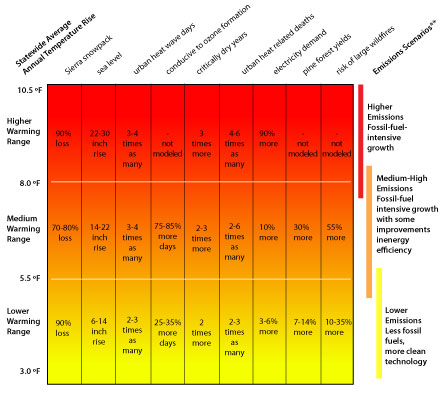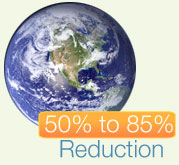Why Efficiency and Conservation?
Global warming is posing new challenges for California communities. Rising temperatures, escalating risks to agriculture, the desiccation of rivers and lakes, the disappearance of snow pack and the threat of flooding in low-lying areas are all realities that California must face. While the situation may seem dire, local governments around the globe are taking action. From San Francisco to Shanghai, leaders are championing conservation and energy efficiency and saving money at the same time.
Click here to see what cities and counties are doing to save money and fight global warming.
The Cheapest Kilowatt and Conservation
As Amory Lovins has been saying for 30 years, the cheapest kilowatt produced is the one saved through energy-efficiency. In recent years, the rising cost of stainless steel and concrete and the precipitous rise in demand for building materials in China has produced a spike in the costs to construct power plants. While coal is still cheap, building a coal-fired plant is not. In May of 2007, after the North Carolina Utilities Commission gave Duke Energy the green light to build a coal-fired plant, the company said it would cost $1.83 billion – 80% higher than their 2005 estimate. As California's cities and counties work to reduce their emissions, employing energy efficiency and conservation before adding costly capacity to the grid is an intelligent choice that will save money and energy.
Read more: "As Costs to Build Power Plants Soar, Energy Efficiency More Attractive Than Ever"
(e-Newswire, 7/17/07)
Rising Temperatures, Peak Demand and Energy-Efficiency Technologies
According to a recent report from the California Climate Change Center, the heat waves that plagued California in August of 2007 are expected to increase with global warming. The report said that the number of days with "T90" temperatures, is expected to double statewide between 2005 and 2034. The extreme heat, along with increased residents in hot parts of the state could push peak demand to 67,000 megawatts (MW) by 2016, well above California's all-time peak of 50,270 MW in July of 2006. To prevent "frequent summer electricity shortages as early as 2020," the report says that peak-shaving technologies such as energy-efficient air conditioners and solar panels must be promoted in air conditioning-dependent regions such as Southern California and the Central Valley.
Read more: "Report: Energy Efficiency, Solar Needed to Hold Down Peak Demand in California as Extreme Heat Events Surge Due to Climate Change"
(e-Newswire, 9/5/07)
Projected Global Warming Impacts:
2070-2099 as Compared to 1961-1990
Source: Union of Concerned Scientists
Global warming is already happening, mostly due to the burning of fossil fuels. Polar ice caps and glaciers are melting at unprecedented speeds. However, we can avoid the most devastating consequences if local governments act swiftly to curb greenhouse gas emissions. Many of the technologies needed to reduce emissions adequately are already available. All we need is the will to use them. Embracing conservation and new efficient and clean technologies is likely to bring economic benefits to our local governments. Failing to act will pose serious risks to our economy and almost certainly cause great hardship.
Global warming is a choice. Energy-efficiency and conservation are part of the solution.





